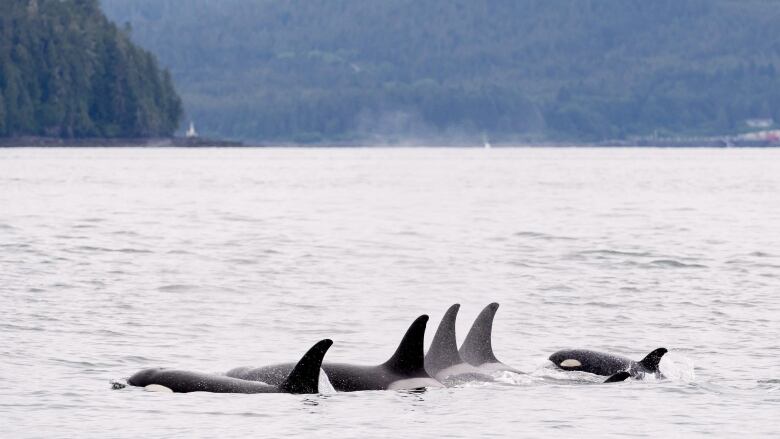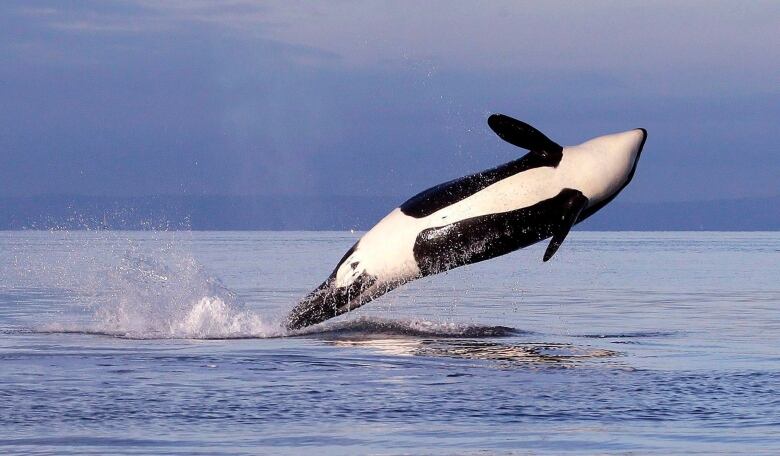Harmful toxins from oil spills, wildfire smoke found in B.C. orcas: study
Researcher says pollutants linked to increased cancer risks, reproduction issues in humans and animals

Harmful pollutants from oil spills, fossil fuels and wildfire smoke have been detected in killer whales inBritish Columbia, according to a new study, which B.C.-based researchers say raisesconcerns about the impacts of fossil fuels and climate change on the iconic coastal mammals.
The study, peer-reviewed and published in thejournal Scientific Reports, identified toxic chemicals known as polycyclic aromatic hydrocarbons (PAHs) in samples of both southern resident killer whales and transient orcas passing through B.C.,including evidence of pollutants passing from a pregnant mother to her baby.
PAHs are found in fossil fuels like oil, gas and coal, and can be released into the ocean via oil spills or by burning fuels for energy or organic matter in a wildfire, according to the study.
Previous studies of humans, animals and orcas elsewhere have linked the "contaminants of concern"to cancer, mutations and reproduction issues.
Identifying the presence of the toxins in B.C. orcasis significant, said senior study author Juan Jos Alava, principal investigator of the University of British Columbia Ocean Pollution Research Unit.
"Killer whales are the canaries in the coal mine, because they're telling us how healthy or how polluted our marine environment, our food web and the marine biodiversity is in B.C.," he told CBC News in a Tuesday interview.

Orcas can inhale PAHs from the air just like humans, Alava said, but they can also absorb toxinsin the water through their skin or by eating plant matter and other animals that have been contaminated.
"The diet can tell us a lot because it's basically the accumulation [of pollution] via the species that they eat," said Alava.
Researchers tested liver and muscle samples from six southern resident killer whales and six transient whales passing through B.C. for 76 different PAHs between 2006 and 2018, finding evidence of some toxins in all 12 whales.
At least 41 toxins appeared in half of the samples, while one PAH derivative, C3, accounted for a third of all pollution detected, according to the study.
Comparing samples between a pregnant mother orcaand her fetus also showed similarities in toxins, suggesting in-utero transfer from mother to baby, researchers found.
There were also somedifferences in the kinds of pollutants found between resident killer whales and transient orcas, a finding Alava says is likely because the two groups have different habitat ranges and diets.
Southern resident killer whales tend to stay closer to urban centres in and around the Salish Sea, eating mostly Chinook and large Pacific salmon, while transient whales roam from Alaska to southern California to hunt larger mammals like otters, seals and sea lions, he said.
Pollution a 'potential cause' of resident orca decline
Alava says the study's findings underline the urgency of phasing out the use of fossil fuels and addressing climate change head-on to protect the already endangered species.
"We need to put in place mitigation action to really prevent more emissions of hydrocarbons coming from oil facilities, from marinas and also precautionary preventive mitigation strategies to avoid wildfires made by humans and anthropocentric climate change," he said.
Alvas says orcas can metabolize PAHs, suggesting the toxins identified are from recent exposures as marine traffic to B.C. portsand fossil fuel projects increases.
There are around 74 southern resident killer whales left in B.C., down from around 100 in the 1990s, and around 500 transient whales along the West Coast of North America, according to the study.
Pollution is among several potential causes of the decline of resident orcas in B.C., according to co-author Stephen Raverty, an adjunct professor at UBC's Institute for Oceans and Fisheries.
Paul Cottrell, marine mammal manager at Fisheries and Oceans Canada, said the study presents "key information to inform management approaches in killer whale habitats."
"The source of the PAHs is often from human activity and it is important we have baseline data on current PAH levels in killer whales to monitor those trends and impacts in marine ecosystems into the future," he said in a Tuesday news release.
With files from Michelle Morton













_(720p).jpg)


 OFFICIAL HD MUSIC VIDEO.jpg)
.jpg)



























































































